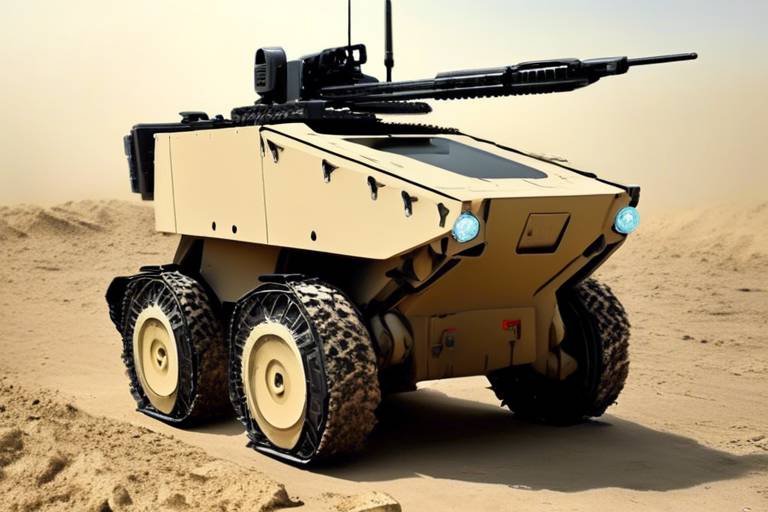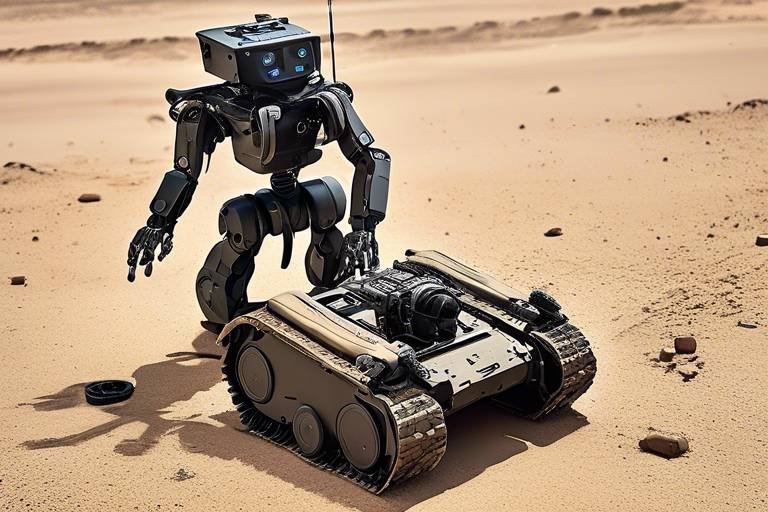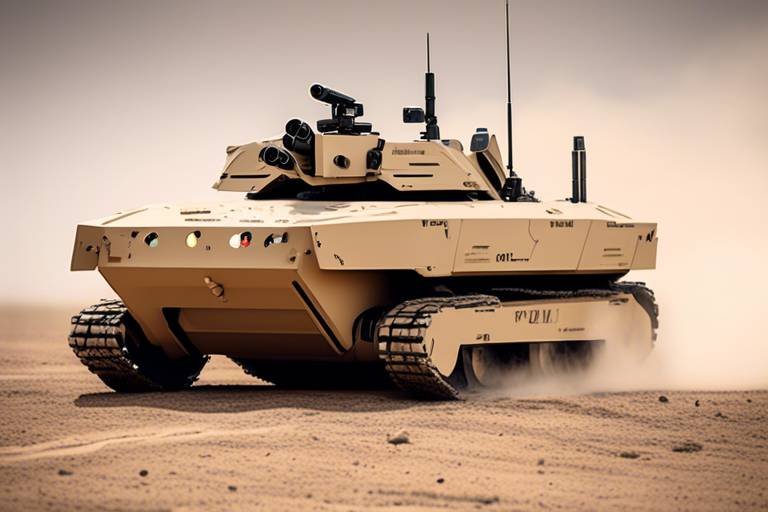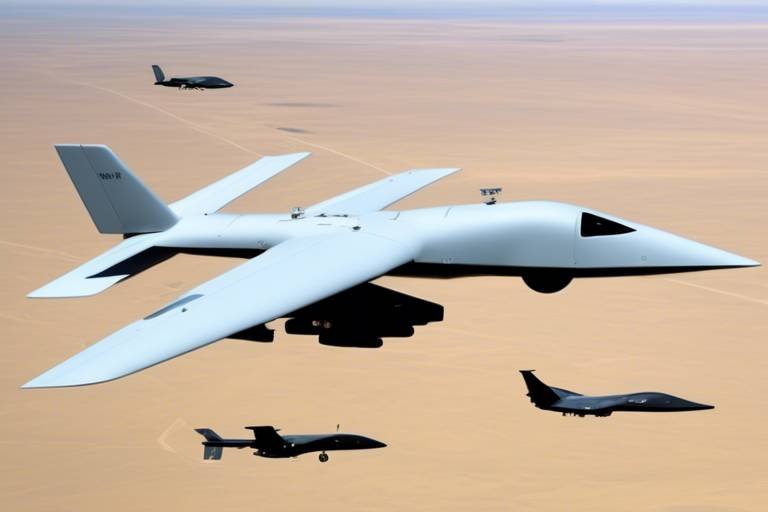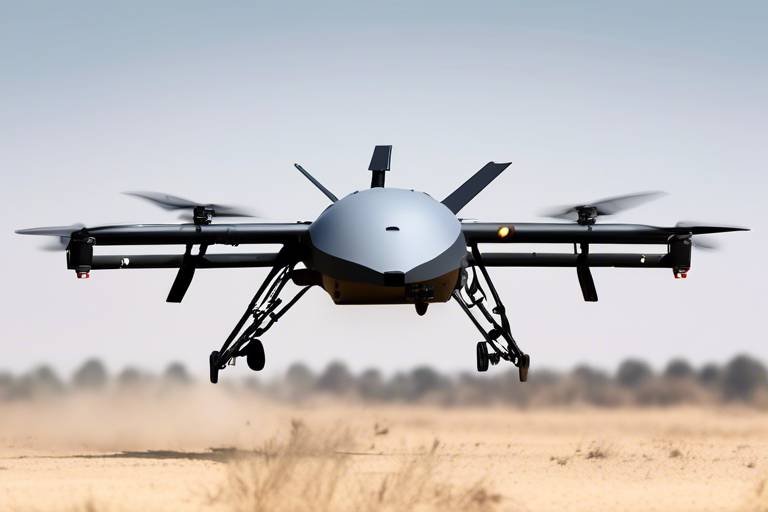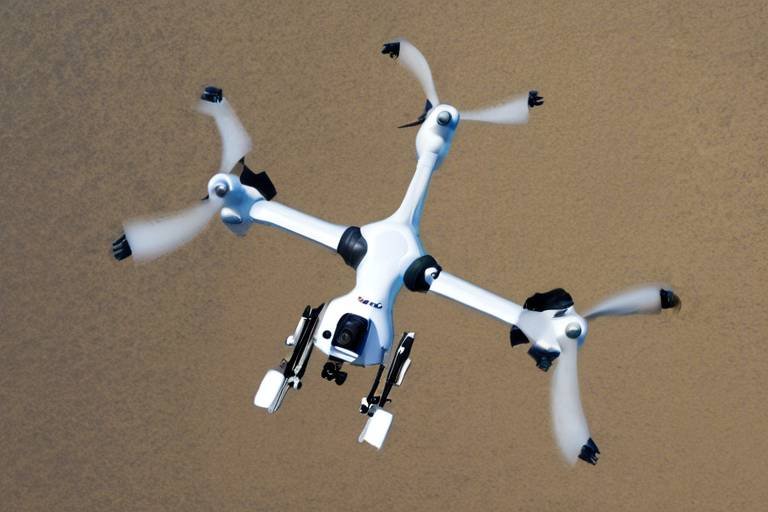The Use of the WARRIOR UGV in Tactical Operations
The landscape of modern warfare is evolving at a breakneck pace, and the introduction of unmanned systems like the WARRIOR Unmanned Ground Vehicle (UGV) is reshaping how tactical operations are conducted. Imagine a battlefield where soldiers can rely on robotic allies to perform dangerous tasks, gather intelligence, and deliver supplies without putting themselves in harm's way. This is not a scene from a sci-fi movie; it's the reality that the WARRIOR UGV brings to the forefront of military strategy. In this article, we will delve into the capabilities, advantages, and applications of the WARRIOR UGV, highlighting its significance in contemporary combat scenarios.
The WARRIOR UGV is a state-of-the-art robotic platform designed to tackle a variety of military tasks. Its robust design and advanced features make it an indispensable asset on the battlefield. Equipped with cutting-edge technology, the WARRIOR UGV can perform missions that range from reconnaissance to logistics support. Its ability to operate in diverse environments—be it urban landscapes, rugged terrains, or remote areas—ensures that it can adapt to the dynamic nature of military operations. The vehicle is not just a tool; it's a force multiplier that enhances the effectiveness of ground troops.
What sets the WARRIOR UGV apart from other unmanned systems? Let's dive into its technical specifications. The WARRIOR UGV boasts impressive mobility, a significant payload capacity, and a suite of advanced sensor systems that collectively contribute to its effectiveness in combat scenarios. For instance, its mobility allows it to traverse difficult terrains, while its payload capacity enables it to carry essential equipment and supplies. The sensor systems are designed to provide real-time data, enhancing situational awareness for commanders on the ground.
One of the standout features of the WARRIOR UGV is its exceptional mobility. Engineered to navigate a variety of terrains, this UGV can handle everything from sandy deserts to muddy battlefields. Its advanced navigation systems, including GPS and inertial navigation, allow it to maintain operational flexibility even in challenging environments. Imagine a soldier needing to scout ahead in a dense forest; the WARRIOR UGV can maneuver through obstacles, providing crucial intelligence without exposing personnel to danger.
Autonomous navigation is a game-changer for unmanned vehicles. The WARRIOR UGV is equipped with sophisticated sensors and algorithms that enable it to navigate independently. This means it can chart its course, avoid obstacles, and adapt to changing conditions without direct human intervention. The result? Increased operational efficiency and reduced risk to human life. The ability to perform tasks autonomously allows military personnel to focus on strategic decision-making rather than getting bogged down in the minutiae of navigation.
While autonomy is essential, the WARRIOR UGV also boasts robust remote control capabilities. Operators can manage the vehicle from a safe distance, ensuring that they remain out of harm's way. This dual capability—autonomous and remote operation—provides flexibility in various operational contexts. Imagine a scenario where troops are under fire; the operator can deploy the UGV to deliver supplies or gather intelligence without risking lives. This combination of features makes the WARRIOR UGV a versatile tool in tactical operations.
The modular design of the WARRIOR UGV is another aspect that enhances its utility. This design allows for various payload configurations, meaning that the UGV can be equipped with different tools and equipment tailored for specific missions. Whether it's carrying medical supplies, reconnaissance equipment, or even weaponry, the WARRIOR UGV can be customized to meet the needs of the operation. This adaptability is crucial in modern warfare, where the ability to respond to rapidly changing situations can mean the difference between success and failure.
The versatility of the WARRIOR UGV is evident in its wide range of applications in military operations. From reconnaissance missions to logistics and combat support, this unmanned vehicle is proving to be a valuable asset on the battlefield. Its ability to perform multiple roles not only enhances operational efficiency but also contributes to the safety of personnel.
Utilizing the WARRIOR UGV for reconnaissance missions significantly enhances situational awareness. Equipped with high-definition cameras and advanced sensors, the UGV can gather intelligence while minimizing risks to personnel. Imagine being able to scout enemy positions without sending soldiers into potentially dangerous areas. The WARRIOR UGV can transmit real-time video feeds, allowing commanders to make informed decisions based on accurate and timely information.
Logistics is the backbone of any military operation, and the WARRIOR UGV plays a vital role in this aspect. By facilitating supply chain operations, it ensures the timely delivery of essential resources to troops in the field. Whether it's transporting ammunition, food, or medical supplies, the UGV can navigate through hostile environments, reducing the logistical burden on ground troops. This capability is especially critical in extended operations where maintaining supply lines can be challenging.
- What is the WARRIOR UGV? The WARRIOR UGV is an unmanned ground vehicle designed for various military applications, including reconnaissance and logistics support.
- How does the WARRIOR UGV navigate? It uses a combination of autonomous navigation systems and remote control capabilities, allowing it to operate independently or be managed from a distance.
- What are the key features of the WARRIOR UGV? Key features include mobility across diverse terrains, a significant payload capacity, and advanced sensor systems for real-time intelligence gathering.
- In what operations is the WARRIOR UGV used? It is used in reconnaissance missions, logistics support, and combat scenarios, enhancing the overall effectiveness of military operations.

Overview of the WARRIOR UGV
The WARRIOR Unmanned Ground Vehicle (UGV) stands as a testament to modern military innovation, designed to meet the ever-evolving demands of tactical operations. This remarkable robotic platform is not just a piece of machinery; it embodies the future of warfare, where technology and strategy intertwine seamlessly. With its robust design and advanced features, the WARRIOR UGV is engineered to perform a multitude of roles on the battlefield, making it an indispensable asset for military forces worldwide.
At its core, the WARRIOR UGV showcases a blend of versatility and resilience. Its architecture allows for easy adaptation to various mission requirements, whether it be reconnaissance, logistics support, or direct combat assistance. The vehicle's ability to operate in harsh environments, from urban landscapes to rugged terrains, demonstrates its all-terrain capability and reliability under pressure. Imagine a soldier's best friend that can traverse landscapes that would challenge even the most skilled human operators—this is what the WARRIOR UGV offers.
Equipped with state-of-the-art technology, the WARRIOR UGV is designed to enhance situational awareness and operational efficiency. It features advanced sensor systems that provide real-time data to operators, allowing for informed decision-making in critical situations. Furthermore, its modular design means that it can be outfitted with various payloads, including surveillance equipment, medical supplies, or even weaponry, depending on the mission's needs. This adaptability not only maximizes its utility but also minimizes the risks faced by personnel in the field.
In summary, the WARRIOR UGV is more than just a robotic vehicle; it is a game changer in tactical operations. Its multi-faceted capabilities ensure that military forces can maintain a strategic advantage, all while keeping personnel safe from harm. As we delve deeper into the specifics of its features and applications, it becomes clear that the WARRIOR UGV is a cornerstone of modern military strategy.
- What is the primary function of the WARRIOR UGV?
The WARRIOR UGV is designed to perform a variety of roles, including reconnaissance, logistics support, and combat assistance. - How does the WARRIOR UGV navigate challenging terrains?
It utilizes advanced navigation systems that allow it to adapt to diverse environments effectively. - Can the WARRIOR UGV operate autonomously?
Yes, it is equipped with autonomous navigation capabilities, enabling it to navigate independently while avoiding obstacles. - What types of payloads can the WARRIOR UGV carry?
The modular design allows for various payload configurations, including surveillance equipment and medical supplies.

Key Features and Specifications
The WARRIOR Unmanned Ground Vehicle (UGV) is a remarkable piece of technology that stands out in modern military operations. Its design is not just about aesthetics; it's engineered for performance and versatility. One of the standout features of the WARRIOR UGV is its ability to operate in a variety of environments, which is crucial in tactical scenarios. Whether traversing rocky terrains or navigating through urban landscapes, this vehicle is equipped to handle it all, making it a reliable asset on the battlefield.
When we talk about the technical specifications of the WARRIOR UGV, we cannot overlook its impressive mobility capabilities. With a robust drivetrain and advanced suspension system, it can easily maneuver over obstacles and rough terrain. The UGV's speed can reach up to 30 km/h, allowing it to quickly reposition in dynamic combat situations. Moreover, its payload capacity is another significant aspect; it can carry up to 500 kg, which means it can transport essential supplies, equipment, or even weaponry, depending on the mission requirements.
| Feature | Specification |
|---|---|
| Maximum Speed | 30 km/h |
| Payload Capacity | 500 kg |
| Operating Range | Up to 100 km |
| Power Source | Hybrid (electric and diesel) |
Another key feature of the WARRIOR UGV is its sensor systems. These advanced systems include high-resolution cameras, thermal imaging, and LiDAR technology, which allow the UGV to gather real-time data and provide situational awareness to commanders. Imagine having a set of eyes in the sky that can see in the dark or through smoke; that's the kind of advantage the WARRIOR UGV brings to the table. This capability not only enhances the effectiveness of reconnaissance missions but also ensures that personnel can operate with a significantly reduced risk of exposure to enemy fire.
What sets the WARRIOR UGV apart is its mobility across various terrains. It can seamlessly transition from rugged mountain paths to flat urban streets, showcasing its adaptability to different operational environments. The vehicle is equipped with advanced navigation systems that utilize GPS and inertial navigation, ensuring that it can find its way even when faced with challenging conditions. This adaptability is crucial for military operations, where the battlefield can change in an instant.
Autonomous navigation is not just a buzzword; it's a game-changer in military technology. The WARRIOR UGV employs cutting-edge algorithms and artificial intelligence to navigate independently. This means it can plan routes, avoid obstacles, and even make decisions based on real-time data. Think of it as having a highly skilled driver who never tires and always stays alert. This capability allows ground forces to focus on their primary objectives, knowing that the UGV can handle navigation with precision.
In addition to its autonomous features, the WARRIOR UGV can be operated remotely. This dual capability is vital for ensuring the safety of operators while maintaining operational effectiveness. The vehicle is equipped with a secure communication system that allows operators to control it from a safe distance, making it an ideal choice for high-risk missions. Imagine being able to send a robot into a potentially dangerous situation while you remain safely behind the lines—this is the reality that the WARRIOR UGV offers.
In summary, the WARRIOR UGV is a powerhouse of technology designed for the complexities of modern warfare. Its combination of mobility, sensor capabilities, and operational flexibility makes it an invaluable tool for military operations. As we continue to explore its applications in tactical operations, it's clear that the WARRIOR UGV is not just a vehicle; it's a transformative asset that enhances the effectiveness and safety of military personnel on the battlefield.
- What kind of terrains can the WARRIOR UGV navigate? The WARRIOR UGV is designed to operate in a variety of terrains, including rocky, urban, and rugged environments.
- How is the WARRIOR UGV controlled? It can be operated autonomously or remotely, allowing for flexibility in different operational scenarios.
- What is the maximum payload capacity of the WARRIOR UGV? The UGV can carry up to 500 kg, making it suitable for transporting various military supplies and equipment.

Mobility and Terrain Adaptability
The WARRIOR UGV is not just another robotic vehicle; it’s a marvel of engineering designed to conquer the most challenging terrains. Imagine a vehicle that can traverse rocky mountains, muddy fields, and urban landscapes, all while maintaining operational efficiency. This adaptability is what sets the WARRIOR apart in tactical operations. Its advanced mobility features ensure that it can navigate through environments that would typically hinder conventional vehicles.
Equipped with a sophisticated all-terrain suspension system, the WARRIOR UGV can absorb shocks and bumps, providing stability even on the roughest surfaces. This system is crucial for maintaining the integrity of the payload it carries, whether that be surveillance equipment or supplies. The vehicle's design allows it to climb steep inclines and cross obstacles, making it an invaluable asset in combat scenarios where terrain can shift from friendly to hostile in an instant.
One of the standout features of the WARRIOR UGV is its adaptive navigation technology. This technology enables the vehicle to assess its environment in real-time and adjust its path accordingly. For example, if the WARRIOR encounters an unexpected obstacle, it can seamlessly reroute itself, ensuring that it reaches its destination without putting operators at risk. This capability is particularly beneficial in reconnaissance missions, where stealth and speed are paramount.
Moreover, the WARRIOR UGV's mobility isn't just about physical movement; it's about strategic adaptability. In modern warfare, the ability to maneuver quickly and efficiently can mean the difference between success and failure. The WARRIOR's design allows it to operate in various environments, including:
- Rugged terrains: Such as mountains and forests.
- Urban areas: Navigating through buildings and streets.
- Desert landscapes: Withstanding extreme temperatures and sand.
- Aquatic environments: Capable of crossing shallow water bodies.
This versatility ensures that military operations can proceed without delay, regardless of the challenges presented by the environment. In essence, the WARRIOR UGV embodies the spirit of adaptability, enabling it to support troops effectively, no matter where the battlefield may be.
Q1: What types of terrain can the WARRIOR UGV navigate?
A1: The WARRIOR UGV is engineered to navigate various terrains, including rugged mountains, urban landscapes, deserts, and even shallow water bodies.
Q2: How does the WARRIOR UGV maintain stability on rough surfaces?
A2: It utilizes an advanced all-terrain suspension system that absorbs shocks and provides stability, ensuring that the payload remains intact.
Q3: Can the WARRIOR UGV adapt its path if it encounters obstacles?
A3: Yes, the UGV is equipped with adaptive navigation technology that allows it to assess its environment in real-time and reroute as necessary.
Q4: Is the WARRIOR UGV suitable for reconnaissance missions?
A4: Absolutely! Its mobility and stealth capabilities make it an ideal choice for reconnaissance, enhancing situational awareness while minimizing risks to personnel.

Autonomous Navigation Systems
The WARRIOR UGV boasts cutting-edge autonomous navigation systems that enable it to traverse complex environments with minimal human intervention. Imagine a soldier on the battlefield, relying on a robotic companion that can not only move through rough terrain but also make decisions in real-time. This capability is a game-changer in tactical operations, allowing for safer and more efficient missions. The autonomous systems are powered by a combination of advanced sensors, artificial intelligence, and machine learning algorithms, which work together seamlessly to create a reliable navigation experience.
At the heart of the WARRIOR UGV's autonomous navigation are its sophisticated sensor arrays. These include:
- LiDAR (Light Detection and Ranging): This technology uses laser pulses to measure distances, creating a detailed 3D map of the surrounding environment.
- GPS (Global Positioning System): Essential for location tracking, GPS ensures that the UGV knows its position on the battlefield.
- IMU (Inertial Measurement Unit): This system helps the UGV maintain its orientation and stability, especially in uneven terrains.
- Camera Systems: High-resolution cameras provide visual feedback, allowing the UGV to identify obstacles and navigate accordingly.
These sensors work in concert to create a robust navigation framework. For instance, when the WARRIOR UGV encounters an obstacle, its LiDAR detects the object, while the camera system captures its image. The onboard AI processes this information and determines the best course of action—whether to navigate around the obstacle or halt until it’s safe to proceed. This level of intelligence significantly reduces the risk of accidents and enhances the UGV's operational capabilities.
Moreover, the autonomous navigation systems are designed to adapt to various environmental conditions. Whether it's a muddy battlefield, rocky terrain, or urban landscapes, the WARRIOR UGV can modify its navigation strategies accordingly. This adaptability is crucial for maintaining operational effectiveness in unpredictable scenarios, ensuring that troops can rely on the UGV in any situation.
In conclusion, the autonomous navigation systems of the WARRIOR UGV are not just about moving from point A to point B; they represent a leap forward in military technology. By integrating advanced sensors and AI, the WARRIOR UGV can navigate autonomously, making it an invaluable asset in tactical operations. As we continue to innovate and enhance these systems, the future of military operations looks increasingly automated and efficient.
Q1: How does the autonomous navigation system improve safety on the battlefield?
A1: The autonomous navigation system reduces the need for personnel to enter hazardous areas, allowing the WARRIOR UGV to gather intelligence and perform missions without putting soldiers at risk.
Q2: Can the WARRIOR UGV operate in all weather conditions?
A2: Yes, the WARRIOR UGV is designed to function in various weather conditions, including rain, snow, and fog, thanks to its advanced sensor technologies that adapt to environmental changes.
Q3: How does the WARRIOR UGV avoid obstacles autonomously?
A3: The UGV utilizes a combination of LiDAR, cameras, and AI algorithms to detect and navigate around obstacles, ensuring a safe path during operations.
Q4: Is remote control still an option for the WARRIOR UGV?
A4: Absolutely! While the UGV is equipped with autonomous capabilities, operators can still remotely control it, providing flexibility in how missions are executed.

Remote Control Capabilities
The WARRIOR Unmanned Ground Vehicle (UGV) is not just a marvel of autonomous technology; it also boasts impressive remote control capabilities that enhance its operational effectiveness in tactical military scenarios. Picture this: a soldier safely stationed miles away from the battlefield, yet able to control a vehicle that is navigating hostile terrain. This is the reality that the WARRIOR UGV brings to the table, allowing operators to manage the vehicle from a secure distance. This duality of operation—autonomous and remote—ensures that the UGV can adapt to various mission requirements, providing flexibility that is crucial in modern warfare.
The remote control system of the WARRIOR UGV is designed to be user-friendly, employing intuitive interfaces that allow operators to engage with the vehicle seamlessly. Using a combination of advanced communication technologies, the operator can send commands and receive real-time feedback, which is essential for making informed decisions on the fly. Imagine being able to see the battlefield through the eyes of the UGV, all while remaining in a safe location. This capability not only enhances situational awareness but also allows for quick responses to emerging threats.
One of the standout features of the WARRIOR UGV's remote control is its robust communication system, which can operate effectively even in challenging environments. The vehicle is equipped with secure, encrypted channels to ensure that communications remain confidential and resistant to interception. This aspect is critical, as battlefield conditions can be unpredictable, and maintaining the integrity of command and control is paramount.
Moreover, the remote control system includes fail-safes and redundancies to ensure that the vehicle remains operational even if one communication link is compromised. Operators can switch between multiple control methods, whether it’s through a handheld device or a more comprehensive command center setup. This versatility means that the WARRIOR UGV can be deployed in a variety of situations, from urban warfare to open battlefield scenarios.
To illustrate the capabilities of the remote control system, consider the following table that outlines the key features:
| Feature | Description |
|---|---|
| Communication Range | Up to 5 kilometers, depending on terrain and obstacles. |
| Control Interfaces | Handheld remote, tablet interface, and command center integration. |
| Fail-Safe Mechanisms | Redundant communication links and automatic return-to-home functions. |
| Real-Time Feedback | Live video feed and telemetry data for situational awareness. |
In conclusion, the remote control capabilities of the WARRIOR UGV significantly enhance its utility in tactical operations. By allowing soldiers to operate the vehicle from a distance, it minimizes risks to personnel while maximizing operational effectiveness. The combination of intuitive controls, robust communication systems, and fail-safe mechanisms makes the WARRIOR UGV a formidable asset on the battlefield.
- What is the maximum range of the WARRIOR UGV's remote control?
The WARRIOR UGV can be remotely controlled from distances of up to 5 kilometers, depending on environmental conditions. - Can the WARRIOR UGV operate autonomously?
Yes, the WARRIOR UGV is equipped with advanced autonomous navigation systems that allow it to navigate independently. - What types of missions can the WARRIOR UGV perform?
The WARRIOR UGV can be utilized in reconnaissance, logistics, and combat support missions, making it a versatile tool on the battlefield. - How does the WARRIOR UGV ensure secure communications?
The vehicle employs encrypted communication channels to maintain the confidentiality and integrity of commands and data.

Payload and Modular Design
The WARRIOR Unmanned Ground Vehicle (UGV) stands out not only for its advanced technology but also for its flexible payload and modular design. This capability allows military forces to tailor the UGV to meet specific mission requirements, making it an invaluable asset on the battlefield. The modular design enables the integration of various tools and equipment, ensuring that the WARRIOR UGV can adapt to a wide range of operational scenarios.
Imagine a Swiss Army knife, but for military operations. Just as that tool can switch between different functions, the WARRIOR UGV can be outfitted with multiple payloads to tackle diverse tasks. Whether it’s carrying surveillance equipment, explosive ordnance disposal tools, or medical supplies, the UGV can be reconfigured quickly and efficiently. This adaptability not only enhances mission success but also minimizes the risks to personnel in high-stakes environments.
One of the key advantages of the WARRIOR UGV’s modular design is its payload capacity. The vehicle can carry a significant amount of weight, allowing it to transport essential supplies and equipment directly to the front lines. For example, it can be equipped with:
- Surveillance cameras for real-time intelligence gathering
- Robotic arms for bomb disposal operations
- Medical kits for rapid response in combat zones
By utilizing these payload options, commanders can enhance their tactical flexibility, ensuring that they have the right tools for any situation. Additionally, the ease of swapping out payloads means that the WARRIOR UGV can operate continuously without lengthy downtime for reconfiguration.
Furthermore, the WARRIOR UGV's design incorporates a user-friendly interface that allows operators to quickly assess and select the necessary payload configurations. This interface is crucial during high-pressure situations, where every second counts. The ability to rapidly adapt the vehicle's capabilities can mean the difference between mission success and failure.
In summary, the payload and modular design of the WARRIOR UGV not only enhances its operational effectiveness but also provides military forces with the versatility they need in modern warfare. As conflicts evolve, the ability to modify equipment on-the-fly will be a game-changer, ensuring that troops are always equipped with the right tools for the job.
- What types of payloads can the WARRIOR UGV carry?
The WARRIOR UGV can carry various payloads, including surveillance equipment, medical supplies, and tools for explosive ordnance disposal. - How quickly can the WARRIOR UGV be reconfigured for different missions?
The modular design allows for rapid reconfiguration, enabling the UGV to be adapted for different missions in a matter of minutes. - Is the WARRIOR UGV suitable for all terrains?
Yes, the WARRIOR UGV is engineered for mobility across diverse terrains, making it effective in a variety of environments.

Applications in Tactical Operations
The WARRIOR Unmanned Ground Vehicle (UGV) has emerged as a game-changer in modern military operations, boasting a range of applications that enhance tactical effectiveness. Its versatility allows it to adapt to various roles, making it an invaluable asset on the battlefield. Imagine a soldier who can send a robotic companion into harm's way to gather intelligence, transport supplies, or support combat operations—all without putting human lives at risk. This is precisely what the WARRIOR UGV offers, and its applications can be grouped into several key areas.
One of the most significant applications of the WARRIOR UGV is in reconnaissance missions. With its advanced sensor systems, the UGV can traverse enemy territory and gather critical intelligence. Equipped with high-definition cameras and thermal imaging, it can detect enemy movements and identify potential threats, all while remaining hidden from view. This capability not only enhances situational awareness for commanders but also minimizes risks for personnel. Imagine sending a UGV to scout out a potentially hostile area, allowing troops to plan their approach with precision and confidence.
Furthermore, the WARRIOR UGV excels in logistics and supply chain support. In military operations, ensuring that troops receive timely supplies can be the difference between success and failure. The UGV can transport ammunition, food, medical supplies, and other essential resources directly to the front lines, navigating through treacherous terrain where traditional vehicles might struggle. This capability not only streamlines logistics but also frees up human resources for more critical tasks. Picture a scenario where a platoon is pinned down in a firefight; the UGV can deliver much-needed supplies without exposing soldiers to danger.
Moreover, the WARRIOR UGV can be utilized for combat support. It can be equipped with various payloads, including non-lethal weapons or surveillance equipment, to assist ground troops during engagements. By providing real-time data and support, the UGV enhances the effectiveness of military operations. This ability to adapt to multiple roles means that the WARRIOR UGV can be deployed in various combat scenarios, from urban warfare to open-field engagements.
In addition to these applications, the WARRIOR UGV's modular design allows for the integration of specialized tools and equipment tailored for specific missions. For example, it can be outfitted with explosive ordnance disposal (EOD) tools, enabling it to safely neutralize threats like improvised explosive devices (IEDs). This adaptability ensures that the UGV remains relevant across a wide range of operational contexts.
As we explore the future of military operations, it is clear that the WARRIOR UGV will play an increasingly vital role. Its ability to enhance reconnaissance, streamline logistics, and support combat operations not only increases the effectiveness of military forces but also prioritizes the safety of personnel. With the continuous advancements in technology, we can expect the WARRIOR UGV to evolve further, potentially incorporating artificial intelligence and machine learning to enhance its operational capabilities.
- What is the primary function of the WARRIOR UGV?
The primary function of the WARRIOR UGV is to assist in military operations by performing tasks such as reconnaissance, logistics support, and combat assistance. - How does the WARRIOR UGV enhance soldier safety?
By allowing soldiers to send the UGV into potentially dangerous situations, it minimizes the risk to human life during reconnaissance and supply missions. - Can the WARRIOR UGV operate autonomously?
Yes, the WARRIOR UGV is equipped with autonomous navigation systems that enable it to navigate independently while avoiding obstacles. - What types of payloads can the WARRIOR UGV carry?
The modular design of the WARRIOR UGV allows it to carry various payloads, including surveillance equipment, EOD tools, and supplies for troops.

Reconnaissance Missions
The WARRIOR UGV shines brightly in the realm of reconnaissance missions, acting as the eyes and ears of military operations. Imagine a soldier on the field, tasked with gathering vital intelligence while navigating through potentially hostile territories. The WARRIOR UGV steps in as a reliable partner, equipped with advanced sensors and cameras that allow it to gather critical data without putting human lives at risk. This robotic marvel can traverse complex terrains, from rugged mountains to urban landscapes, all while remaining undetected.
One of the standout features of the WARRIOR UGV is its ability to operate in real-time, sending back high-definition imagery and data to command centers. This capability enhances situational awareness, enabling commanders to make informed decisions swiftly. The UGV can be deployed in various scenarios, such as:
- Surveillance of enemy positions
- Monitoring troop movements
- Assessing damage after an engagement
- Gathering intelligence on potential threats
By utilizing the WARRIOR UGV for reconnaissance, military forces can significantly reduce the risks associated with human reconnaissance teams. Instead of sending soldiers into potentially dangerous zones, the UGV can scout ahead, providing real-time feedback and allowing troops to plan their next moves strategically. This not only saves lives but also enhances the overall effectiveness of military operations.
Moreover, the modular design of the WARRIOR UGV allows for the integration of various reconnaissance tools, such as thermal imaging cameras, night vision systems, and environmental sensors. These tools enable the UGV to operate effectively in diverse conditions, whether it's a bright sunny day or under the cover of darkness. The adaptability of the WARRIOR UGV is a game-changer, allowing it to gather intelligence in ways that were previously unimaginable.
In summary, the WARRIOR UGV's role in reconnaissance missions is pivotal. It combines cutting-edge technology with operational flexibility, ensuring that military forces can stay one step ahead of their adversaries. As we look to the future of warfare, the importance of such unmanned systems cannot be overstated. They represent not just a technological advancement but a significant evolution in how we approach military strategy.
Q1: How does the WARRIOR UGV enhance situational awareness during reconnaissance missions?
A1: The WARRIOR UGV enhances situational awareness by providing real-time high-definition imagery and data to command centers, allowing for informed decision-making without risking human lives.
Q2: Can the WARRIOR UGV operate in various weather conditions?
A2: Yes, the WARRIOR UGV is equipped with advanced sensors and cameras that enable it to operate effectively in diverse weather conditions, including rain, fog, and darkness.
Q3: What types of reconnaissance tools can be integrated into the WARRIOR UGV?
A3: The WARRIOR UGV can be outfitted with various reconnaissance tools, such as thermal imaging cameras, night vision systems, and environmental sensors, allowing for versatile operational capabilities.
Q4: How does the use of the WARRIOR UGV impact troop safety?
A4: By deploying the WARRIOR UGV for reconnaissance, military forces can minimize the risks to personnel by scouting potentially dangerous areas remotely, reducing the need for human reconnaissance teams in high-risk situations.

Logistics and Supply Chain Support
The role of the WARRIOR UGV in logistics and supply chain support is nothing short of revolutionary. Imagine a battlefield where every second counts, and the need for timely supplies is paramount. The WARRIOR UGV steps in as a reliable partner, ensuring that troops receive essential resources without exposing personnel to unnecessary risks. This unmanned ground vehicle is not just a piece of equipment; it’s a lifeline that enhances operational efficiency and safety.
Equipped with advanced navigation systems and a robust payload capacity, the WARRIOR UGV can transport a variety of supplies, from ammunition to medical equipment. Its modular design allows for quick reconfiguration, enabling it to adapt to different mission requirements seamlessly. For instance, one minute it might be hauling food and water supplies, and the next, it could be delivering critical spare parts to maintain operational readiness. This flexibility is crucial in dynamic environments where conditions can change rapidly.
Moreover, the WARRIOR UGV is designed to operate in diverse terrains, which is essential for logistics operations in challenging landscapes. Whether traversing rocky mountains or navigating through urban rubble, its superior mobility ensures that it can reach troops in need without delay. This capability is further enhanced by its autonomous navigation systems, which allow it to avoid obstacles and select optimal routes without requiring constant human supervision.
In addition to its transportation capabilities, the WARRIOR UGV can also serve as a mobile command center. This function allows it to coordinate logistics operations in real-time, ensuring that supply chains remain fluid and responsive. Imagine a scenario where a unit is cut off from traditional supply routes; the WARRIOR UGV can be deployed to deliver supplies directly to the front lines, significantly reducing the time it takes to get vital resources to those who need them most.
To illustrate the impact of the WARRIOR UGV on logistics, consider the following table that summarizes its key advantages:
| Feature | Advantage |
|---|---|
| Modular Design | Quick reconfiguration for various missions |
| Autonomous Navigation | Reduces need for human oversight; enhances safety |
| Payload Capacity | Can transport a wide range of supplies |
| Terrain Adaptability | Effective in diverse and challenging environments |
In summary, the WARRIOR UGV’s contributions to logistics and supply chain support are invaluable. It not only improves the efficiency of supply operations but also ensures the safety of personnel on the battlefield. By integrating cutting-edge technology with practical applications, the WARRIOR UGV stands as a testament to the future of military logistics.
- What types of supplies can the WARRIOR UGV transport? The WARRIOR UGV can transport a variety of supplies, including ammunition, medical equipment, food, and water.
- How does the autonomous navigation system work? The autonomous navigation system uses advanced sensors and algorithms to detect obstacles and determine the best route, allowing the UGV to operate independently.
- Can the WARRIOR UGV operate in urban environments? Yes, the WARRIOR UGV is designed to navigate both rugged terrains and urban landscapes, making it versatile for various operational contexts.
- How quickly can the WARRIOR UGV be reconfigured for different missions? The modular design allows for rapid reconfiguration, enabling the UGV to adapt to different mission requirements in a matter of minutes.
Frequently Asked Questions
-
What is the WARRIOR UGV?
The WARRIOR Unmanned Ground Vehicle (UGV) is a cutting-edge robotic platform designed for military applications. It is engineered to enhance operational efficiency in tactical missions, providing support in reconnaissance, logistics, and combat scenarios.
-
How does the WARRIOR UGV navigate different terrains?
The WARRIOR UGV is equipped with advanced mobility features that allow it to traverse various terrains effectively. Its navigation systems are designed to adapt to challenging environments, ensuring operational flexibility and reliability in the field.
-
Can the WARRIOR UGV operate autonomously?
Yes, the WARRIOR UGV is capable of autonomous navigation. It utilizes sophisticated technologies that enable it to navigate independently while avoiding obstacles, making it a valuable asset in tactical operations.
-
What are the remote control capabilities of the WARRIOR UGV?
In addition to its autonomous features, the WARRIOR UGV can be operated remotely. This allows operators to control the vehicle from a safe distance, ensuring personnel safety while maintaining operational effectiveness.
-
What types of payloads can the WARRIOR UGV carry?
The modular design of the WARRIOR UGV allows for various payload configurations. It can be equipped with different tools and equipment tailored for specific missions, enhancing its versatility on the battlefield.
-
How does the WARRIOR UGV support reconnaissance missions?
The WARRIOR UGV enhances situational awareness during reconnaissance missions by gathering intelligence while minimizing risks to personnel. Its advanced sensor systems allow for effective data collection in potentially dangerous environments.
-
What role does the WARRIOR UGV play in logistics?
The WARRIOR UGV plays a crucial role in logistics by facilitating supply chain operations. It ensures the timely delivery of essential resources to troops in the field, which is vital for maintaining operational readiness.

